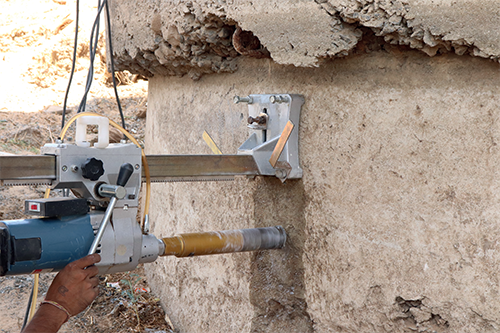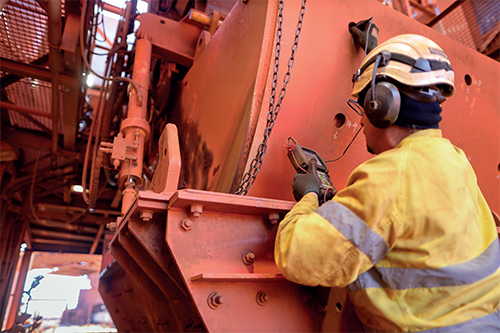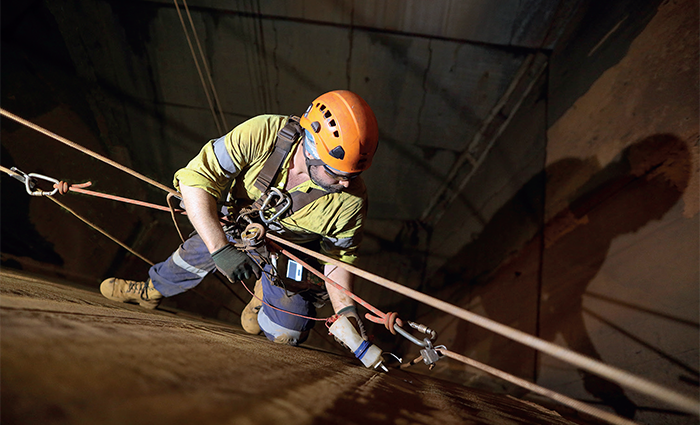Nondestructive testing By Ricky L. Morgan
Testing times
Nondestructive testing: An essential element of maintaining a healthy infrastructure
By Ricky L. Morgan
In Hollywood disaster films, it is necessary to compel the audience into believing the earthquake, storm, or flood is truly devastating. To do this, filmmakers show bridges falling, buildings twisting, roads buckling, and more. If the audience has any questions whether the event is indeed severe, such images bring them instantly to a state of complete belief.
In the real world, such things can, and do, happen, though fortunately they are far more rare than in movies such as the blockbuster San Andreas. At least part of the reason is that a sophisticated, but little-discussed technology, is applied during and after construction. This one approach makes a world of difference. So, it is troubling that as the US considers how to apply the more than $1.2 trillion in authorized spending on infrastructure, and other countries around the world consider how to further build out their environments, wider adoption of this technology is not prioritized so our cities and communities don’t mirror a Hollywood disaster film during storms and other natural events.
Nondestructive testing (NDT) is the inspection of an object for cracks, corrosion, discontinuities, or structural fatigue without cutting or breaking the object open. In the best-case scenario, there are careful considerations made throughout the design and construction process of every building and structure to ensure structural integrity during a variety of natural conditions as well as the structure’s integrity over the long term. To ensure longevity, regular inspection and evaluation of materials using NDT is vitally important. It can prevent the usage of flawed materials. It can ensure that the welds that join building elements together are sound. And it can be applied throughout the life of the structure to examine if the materials and structure retain their ability to withstand earthquakes, severe storms and similar events.
Protocols and procedures
From the day materials arrive at a fabrication facility to the day an asset is demolished or mothballed, NDT should be performed to confirm integrity. Especially with respect to infrastructure, NDT can be utilized from the cradle to the grave of an asset. This includes the entire built environment ranging from bridges, dams, power lines, cellular towers, airports, runways, water facilities, and power plants to refineries, roads, and more. NDT provides an array of analysis techniques that can be used in the construction and maintenance of such facilities to evaluate the materials, components, and assemblies of these buildings and structures without causing damage.
When the 1994 Northridge Earthquake struck the California San Fernando Valley, it was NDT inspectors – including me – who examined the infrastructure. The evaluation of the status of steel structures in potentially damaged buildings was essential to determine repair protocols and procedures for future construction of replacement facilities when a structure was too damaged to save. NDT inspectors worked day and night to provide this critical information to both asset owners and the engineers racing to determine the status of the affected buildings and structures.
Today, the NDT industry is digital and dynamic, utilizing some of the most advanced assessment technologies available. There are currently more than 11 different recognized methods of NDT and countless subsets and techniques available for almost every industry. While it depends on the project specifications and the inspection and testing plan that spells out the areas where inspection is required, the most common NDT methods are Magnetic Particle Testing (MT), Penetrant Testing (PT), Ultrasonic Testing (UT), Radiographic Testing (RT), and Visual Testing (VT). Think of it as advanced science applied to a single compelling priority – public safety.
 Many enhancements have been made to evolve NDT technologies to where they are today. This does not mean NDT has advanced as far as it can. Further advancements in NDT could provide useful figures for data-driven, risk-based assessments throughout the life cycle of building elements and structures.
Many enhancements have been made to evolve NDT technologies to where they are today. This does not mean NDT has advanced as far as it can. Further advancements in NDT could provide useful figures for data-driven, risk-based assessments throughout the life cycle of building elements and structures.
Improving inspections
Newer innovations are in development or coming into use. These include advancements such as advanced UT methods, like Phased Array Ultrasonic Testing (PAUT), Time of Flight Diffraction (TOFD), and Total Focusing Method (TFM)/Full Matrix Capture (FMC). Such tools can have a great impact on the inspection of infrastructure. Already, innovations in conventional UT have been shown to provide better imagery, better probability of detection, better characterization of flaw or failure type, and more robust post processing and analysis. Similarly, the use of drones has been shown to significantly improve visual inspection of infrastructure assets with limited access by supplementing technologies with safer access, greater picture quality, and a permanent record using geotagging. In the past, those structures may have only been able to be assessed using binoculars. Similarly, Structural Health Monitoring (SHM) and Condition Monitoring (CM) are not novel technologies but have been significantly enhanced by improvements in sensor technology, as well as better and more useful data acquisition. Today, monitoring can be ongoing 24/7, scheduled, incident activated, or even mounted or embedded into steel and concrete infrastructure during new construction to monitor a structure throughout its lifetime.
Evolving technology
As we in the US prepare to spend over a trillion dollars on new infrastructure investments and other nations continue their development, we should make certain NDT technologies are more widely adopted and required so the public can be sure they are safe.
We may not be living in a Hollywood movie, but as our natural environment changes there is no question disasters risk becoming more frequent and more severe. The regular application of NDT inspections on aging infrastructure is essential to maintain its stability. And NDT must be applied to new builds, from the material production stage all the way through construction.
Throughout the decades, NDT technology has consistently evolved to meet the ever-growing need for infrastructure assets to withstand unpredictable and severe weather conditions. We must continue to invest in the innovation of NDT methods and the creative utilization of this valuable and rapidly evolving technology.
Ricky Morgan
flawtech.com
Ricky Morgan is the President of FlawTech America, a manufacturing company providing the very best in intentionally Flawed Specimens to the NDT/NDE Industry for more than 40 years. FlawTech also supports the American Society for Nondestructive Testing (ASNT), the world’s largest technical society for NDT professionals, by bringing together ASNT members and NDT technicians.
American Society of Nondestructive Testing (ASNT): www.asnt.org
